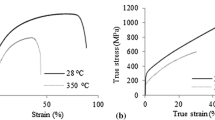Conclusions
-
1.
Plastic deformation of austenite in the metastable temperature range leads to a reduction in the effective size of coherent scattering regions. With increasing strain rates the effective size of blocks decreases.
-
2.
The true size of coherent scattering regions averages 20% smaller after LTMT than after standard heat treatment. With increasing rates of plastic deformation the true size of coherent scattering regions remains unchanged.
-
3.
The concentration of deformation and twin stacking faults after LTMT increases with increasing deformation and increasing strain rates. When the strain rate is increased by two orders the concentration of deformation stacking faults doubles.
-
4.
The variation of the dislocation density with deformation is linear. With increasing strain rates the dislocation density decreases.
-
5.
The inversely proportional relationship between the dislocation density and strain rate in LTMT is due to dynamic strain aging of austenite.
Similar content being viewed by others
Literature cited
F. A. McClintock and A. S. Argon, Deformation and Fracture [Russian translation], Mir, Moscow (1970).
M. Kh. Shorshorov et al., Thermoplastic Hardening of Martensitic Steels and Titanium Alloys [in Russian], Nauka, Moscow (1971).
A. P. Gulyaev and A. S. Shigarev, "Effect of thermomechanical treatment on fine structure," Metalloved. Term. Obrab. Met., No. 5, 9 (1963).
B. I. Warren, "X-ray analysis of deformed metals," in: Advances in Physics of Metals [Russian translation], Vol. 5, Metallurgizdat, Moscow (1963), p. 172.
Ya. S. Umanskii, X-Ray Analysis of Metals [in Russian], Metallurgiya, Moscow (1967).
R. Rothman and J. Cohen, Adv. X-Ray Anal., No. 12, 208 (1968).
C. Wagner, in: Local Atomic Arrangement Studied by X-Ray Diffraction, I. B. Cohen and J. E. Hilliard, eds., Gordon and Breach, New York (1966), pp. 217.
K. Williamson and R. Smallman, Phil. Mag.,8, No. 1, 34 (1956).
L. Raymond and W. Reyter, Acta Met.,12, No. 8, 948 (1964).
A. Soler-Gomez and W. Tegart, Phil. Mag.,20, No. 165, 495 (1969).
A. Wijler and Schade van Westrum, Ser. Metallurgica,5, No. 2, 159 (1971).
A. Wijler, M. Vrÿhoef, and A. Van den Beukel, Acta Met.,22, No. 1, 13 (1974).
Additional information
Physicotechnical Institute, Academy of Sciences of the Belorussian SSR. Translated from Metallovedenie i Termicheskaya Obrabotka Metallov, No. 4, pp. 24–27, April, 1979.
Rights and permissions
About this article
Cite this article
Sevast'yanov, E.S., Strikelev, A.I. & Rakhov, I.V. Fine structure of steel 5Kh3V3MFS after LTMT and standard heat treatment. Met Sci Heat Treat 21, 273–277 (1979). https://doi.org/10.1007/BF00775107
Issue Date:
DOI: https://doi.org/10.1007/BF00775107




